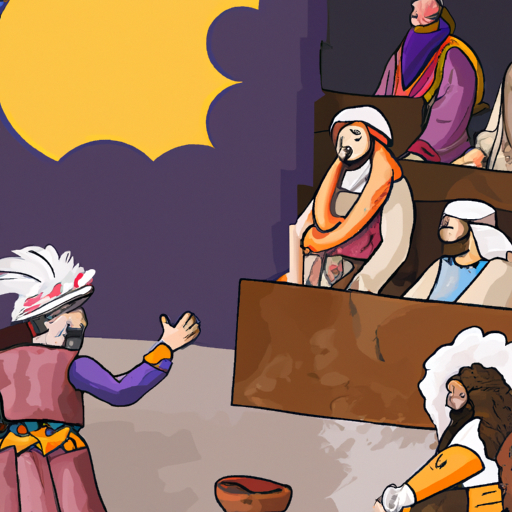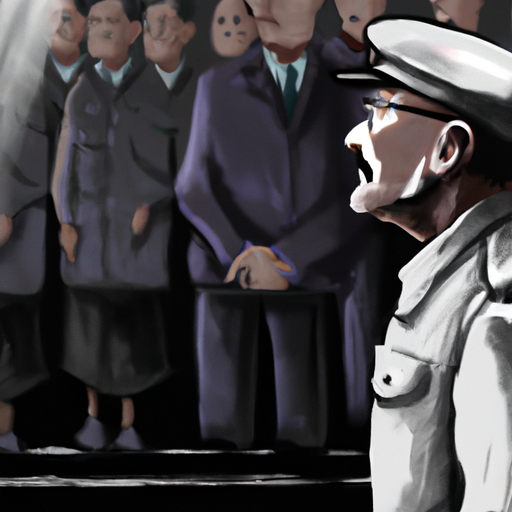History of the Great Social Evil of the Victorian Age
Unearth the past and delve into the tremendous societal blight of the Victorian Era! Uncover secrets, traverse time, and unravel the mysteries that shroud this period of history. Examine how it impacted society and ponder its reverberations in our modern world. Delve deep into a bygone era and explore the great social evil of the Victorian Age!

History is an enigmatic instructor, full of unpredictable lessons. The Victorian Era (1837-1901) was an era of remarkable social, economic, and political transformation in Britain, yet also a time of immense tribulation. During this period, the Industrial Revolution brought about drastic technological advancements and rapid population growth which caused cities to become overcrowded with substandard housing and sanitation systems, leading to illnesses and deaths in abundance. Poverty was rampant as wages failed to keep up with rising prices; women were deprived of basic rights; child labor was a common occurrence in factories; and crime ran rampant due to ineffective policing.
It is essential that we remember the suffering of our predecessors so that we can use it to inform our current decisions. We must strive to comprehend how these issues came into existence and how they continue to influence our society today. By carefully examining this period in history, we can gain understanding into how our modern world has been shaped by its heritage. Through reflecting on past errors, we can make sure similar injustices are not repeated in the future.
Introduction

A time of vast industrial development and burgeoning cities, the Victorian Age was also marked by immense disparity between classes as well as a rise in criminal activity, prostitution, and other vices. This period of societal discord was referred to as the “great social evil” by William Ewart Gladstone in 1845, a title that aptly fit the dire circumstances many were facing. The destitution had become so intense that people were living on the streets or in slums; child labor was accepted practice and wages for factory employees were meager. Although reformers sought to improve conditions, this great social evil endured until deep into the twentieth century.
– Historical Overview of Social Evils in the Victorian Age
The Victorian Age was a time of remarkable transformation and growth in numerous aspects, yet also marked the commencement of some of the most appalling social wrongs ever seen. From child labor to destitution and oppressive gender roles, Victorians confronted a range of difficulties that shaped their culture. This article will provide an overview of these social maladies and how they influenced the lives of people living during this period.
Child labor was rampant throughout the Victorian Age, with kids as young as five being employed in factories and other places of work. Many were subjected to long hours, hazardous conditions, and meager wages. This exploitation led to physical and psychological hardship for many children, who often had no alternative but to accept such circumstances in order to survive.
Poverty was likewise widespread during this era, with vast numbers of people living in unsanitary conditions due to a lack of jobs or resources. The affluent classes had access to better education and healthcare than their poorer counterparts, creating a sharp divide between those who could pay for such luxuries and those who could not.
Gender roles were highly restrictive during the Victorian Age, with women expected to stay at home while men ventured out into the workforce. Women were denied fundamental rights such as voting or owning property, which further limited their chances for progress. This inequality meant that women were regularly exposed to mistreatment from their husbands or employers without any legal recourse available to them.
These social wrongs had an enduring effect on society throughout the Victorian Age and beyond. While there have been some improvements since then, many of these issues remain pertinent today as we carry on striving for greater equality among all members of our society.
– Exploring the Impact of Social Evils on Victorian Society
The Victorian period, spanning 1837 to 1901, was a time of immense transformation and growth. The dawn of industrialization, urbanization and further technological advancement were all hallmarks of this era; however, it also saw the rise of certain social evils that had a dramatic effect on the lives of those living in it. By delving into the history of these social issues and their effects on Victorian society, we can gain insight into how they continue to shape our world today.
One such issue was poverty. With the influx of people to cities and towns for work came an overcrowding which resulted in inadequate housing conditions for many families. These dire circumstances often led to malnutrition, illness and even crime as well as other forms of exploitation due to class divisions.
Child labor was another prevalent problem during this time. As factories became more common, children were employed there at very low wages or no pay at all. This form of abuse caused physical harm due to long working hours and dangerous conditions as well as denied them education and other developmental opportunities.
Prostitution was also a common practice among women who lacked economic resources or were desperate for money due to poverty or other reasons. This could have devastating effects on health as well as self-esteem and sense of worthiness in society overall.
Alcohol abuse was yet another major issue during this era with far-reaching consequences for individuals and society alike. Although alcohol consumption may have been seen as a way to cope with one’s troubles, it oftentimes led to addiction, financial ruin, violence and even death if not addressed properly.
By examining the background behind these social issues we can gain understanding not only about how they shaped Victorian society but also how they continue to influence our world today – a reminder that while much has changed since then there are still numerous challenges that need addressing in order for us all to live better lives together now and in the future!
– Causes and Consequences of Social Evils in the Victorian Period
A period of flux and revolution, the Victorian Age in Britain was a time of great technological and industrial innovation. Yet, it also brought forth some of the most heinous and egregious social injustices known to man. From poverty to child labor to prostitution, these issues affected all strata of society, with both economic and cultural factors playing a role. The industrial revolution created massive wealth for some while leaving countless others in abject destitution; meanwhile, traditional values such as classism and patriarchy kept people from achieving any kind of upward mobility or betterment in their lives.
The ramifications of this period were far-reaching and long-lasting. Those living in poverty faced inadequate housing, malnutrition, lack of education, and limited access to health care. Child labor meant children were often put through gruelling hours with no pay or meager wages in perilous conditions. Prostitution was an especially damaging form of exploitation as women were often driven into it by desperation or coercion from men who sought to benefit from their vulnerability.
These social evils have had a lasting impact on Victorian society that is still felt today, not only in terms of the physical suffering endured by those affected but also due to the psychological trauma caused by the stigma attached to certain forms of poverty or exploitation. To this day, we strive for greater equality and justice for all citizens regardless of their class or gender – a legacy that began during this tumultuous era in British history.
– Understanding the Role of Religion in Combating Social Evils in the Victorian Age
Amidst the tumult and confusion of a changing social landscape, the Victorian Age saw many people grappling to comprehend the role of religion in overcoming societal wrongs. Faith was perceived as an instrument for achieving progress and reform, with religious teachings providing moral standards to challenge inequality and injustice. William Wilberforce’s tireless crusade against slavery culminated in the Abolition Act of 1833, which abolished slavery throughout the British Empire. Education was also held in high regard during this period, allowing individuals to gain knowledge about their faith and its principles so as to recognize immoral practices or customs. Organizations such as The Church Missionary Society provided financial aid for those wishing to combat social issues through schools, hospitals and charitable causes. Moreover, religious leaders used their pulpits to spread messages about justice and fairness, encouraging people to take action against injustices they encountered or campaign for legislative changes that would benefit society at large. All things considered, religion had a considerable impact on opposing social evils in the Victorian Age due mainly to its capacity to supply moral direction and motivation for those seeking positive change within society; without it, many of today’s reforms may have never been realized.
– Examining How Social Reformers Tackled Social Evils During the Victorian Era
Amidst the period of the Victorian era, a surge of social reformers sought to address the numerous issues that were present in society. William Wilberforce, Lord Shaftesbury and Josephine Butler are some of the most renowned figures, each tirelessly working for various causes such as abolishing slavery, bettering working conditions for children and advocating for women’s rights respectively. These reformers were able to make a difference by pushing for changes in laws and regulations which addressed matters like poverty, disease, exploitation and inequality. Thanks to their efforts, they laid down the framework which we still benefit from today – allowing us to live in a more equitable world. To gain an insight into how our society has evolved over time, it is essential to study these historic social reformers.
conclusion

A period of drastic industrialization and population growth during the Victorian Age brought about a deep-seated social affliction – that of poverty, inequality, and injustice. The cities were overcrowded and resources for those living in destitution were scarce. With little to no governmental oversight in regulating economic and social policies, these disparities endured until reforms were finally implemented at the commencement of the new century.
Some questions with answers
Q1. What is the great social evil of the Victorian Age?
A1. The great social evil of the Victorian Age was poverty, which was caused by a number of factors including rapid population growth, industrialization, and low wages.
Q2. How did poverty affect people in the Victorian Age?
A2. Poverty had a wide range of effects on people during the Victorian Age, including poor health and nutrition, lack of education and access to resources, overcrowded housing conditions, and a high crime rate.
Q3. What were some measures taken to address poverty in the Victorian Age?
A3. Many measures were taken to address poverty in the Victorian Age, such as laws that provided for minimum wages and better working conditions, public assistance programs for those who could not work due to age or disability, and educational reforms.
Q4. How did society view poverty during this time?
A4. Society viewed poverty as a sign of moral failure during this time, believing that it was caused by laziness or other character flaws rather than structural issues.
Q5. What can we learn from the great social evil of the Victorian Age?
A5. We can learn from the great social evil of the Victorian Age that poverty is often caused by systemic issues such as industrialization or economic inequality rather than individual character flaws or bad decisions.





